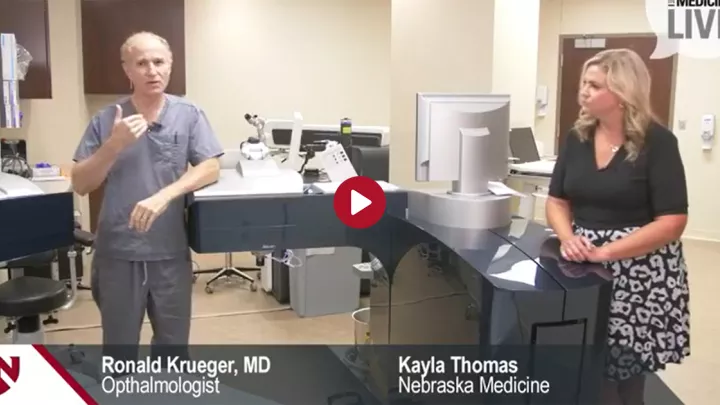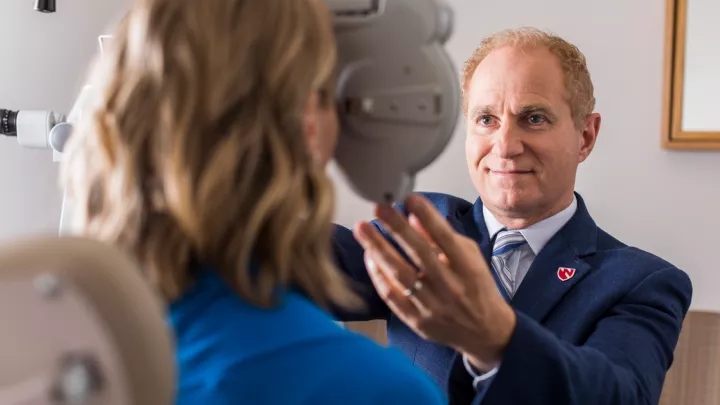How LASIK surgery is done

Are you thinking about getting LASIK but worried about the procedure? Let me tell you what it's like.
Leading up to the surgery, I was worried about two things. One, would it hurt, as I'd be awake during the whole thing. I heard that the laser portion of the procedure takes about five minutes per eye, but that can seem like an eternity.
Two, I was worried about closing my eyes and the laser searing a path through my eyelid.
After meeting with Ronald Krueger, MD, for my free consultation, I felt a lot better. For one thing, I knew I'd be in good hands. Dr. Krueger has performed more than 25,000 vision correction procedures, so he's heard of every fear out there. He assured me that they use numbing drops on the eyes, so patients don't experience any pain. The only part that some people notice is the suction on the eyes, which causes some discomfort.
He also let me know that they use an eye speculum to keep people from blinking during the surgery. So I wouldn't have to worry about that, either.
Finally, if people want a little extra soothing, Dr. Krueger also prescribes a small amount of calming, anti-anxiety medication for the procedure itself. It's optional, but of course, I said yes.
How LASIK eye surgery is performed
Eye surgery reshapes the cornea to give you better vision. The cornea is a clear layer of the eye that focuses light so you can see. How your cornea bends light is how your eye focuses. If you're near-sighted, the cornea bends light too much.
"The laser resurfaces the cornea so it focuses perfectly," Dr. Krueger says. "We can precisely correct the surface into a better shape than what nature gave you."
After evaluating my eyes with multiple tests and images, Dr. Krueger deemed me a candidate for Contoura laser vision correction. Contoura is topography-guided LASIK. It's an advanced procedure that maps out small irregularities on your eye that glasses could never fix. At an appointment before the surgery, the eye care team takes several images of your eye to pinpoint the exact spots where your vision has tiny imperfections. The laser can precisely target those areas to smooth them over, meaning it can correct vision better than glasses or contact lenses. I was excited to see how well it worked.
What LASIK feels like
The day of the surgery, I took the prescribed anti-anxiety medication 20 minutes before the procedure started. Then I went into the room and things got underway. First, someone from the eye care team applied numbing eye drops to each eye. The drops started working in seconds. While Dr. Krueger made small marks on my eyes, I felt nothing at all – not even any pressure or sensation.
Then I laid down on the laser bed. Dr. Krueger put an eye speculum in my right eye so I wouldn't blink during the time that my eyes needed to stay open.
Then this weird suction ring device was applied to my right eye. The suction is applied so that a femtosecond laser can cut a flap in the top layer of the cornea to provide access to the inner layers of the cornea. That part was a bit uncomfortable due to the pressure around my eye. It didn't hurt, but it did feel unnatural. After the first laser created the flap, Dr. Krueger removed the suction ring, telling me, "The worst part is over."
I was next swung over to the second laser on the rotating laser bed without needing to sit up. The eye care team wiped and cleaned each of my eyelids and lashes with a Betadine sponge. Then, Dr. Krueger placed adhesive tape over my eyelashes so they would be kept out of the way during the sterile part of the procedure. He joked that by doing so, "the laser wouldn't cut off my eyelashes." Dr. Krueger gently separated and lifted the corneal flap folding it over with what looked like wide tweezers. I was now ready for the corrective part of the procedure.
As directed, I stared at a distant green blinking light. When the laser began its work, it looked downright psychedelic – purples and pinks were splashed across my whole field of vision in a moving work of art. In a matter of seconds, the excimer laser removed little tiny bits of tissue from the cornea with tiny little pulses at a rate of 500 pulses per second. As Dr. Krueger promised, it was completely painless. The laser interaction smelled a bit like burnt rubber, but Dr. Krueger told me there was no burning or combustion going on; rather the smell was high-velocity corneal particles and plume flying off the surface.
Then Dr. Krueger gently replaced the flap with his instrument. I still felt absolutely nothing on my eye – the numbing drops worked perfectly. He then repeated the same steps on my left eye. Knowing what to expect made it feel like it went much faster.
The whole process took about 10 to 15 minutes per eye. After getting up from the bed, my vision was shimmery, like I was looking underwater. I could see shapes and colors, but nothing was in sharp focus. They gave me some sunglasses to wear, which helped because the sun outside was intense. After my husband drove me home, I slept for two hours. By that afternoon, I was already starting to see clearly. I put in my two types of eye drops for the first time and was surprised to taste them in the back of my throat. I was assured this is normal and to drink water to wash away the taste.
Before the procedure, I couldn't make out the top line of the eye chart during my eye exam. By the evening after the surgery, I was shocked to clearly see the portraits in my dining room from over 20 feet away.
The next day, I went in for a quick check-up. Both of my eyes now have 20/15 vision (even better than 20/20)! LASIK was definitely worth it.






